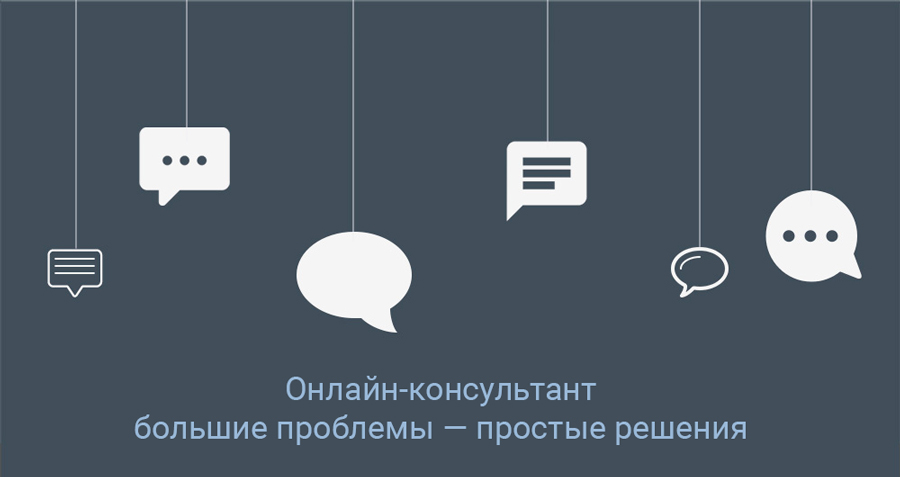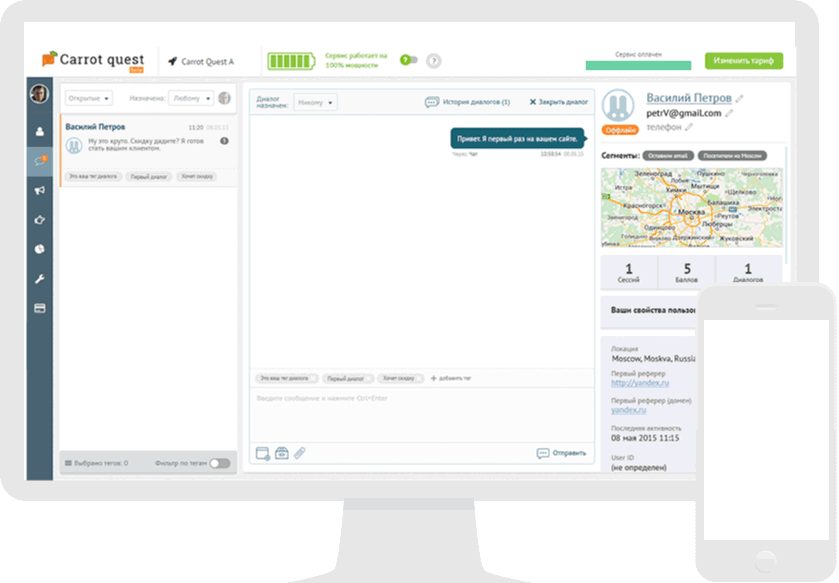Online chat in small business: to be or not to be?

On two of the three sites that provide services or sell goods, we are met by the annoying window of an online consultant, invites us to quickly get answers to the most questions.
The function seems very convenient: the consumer does not need to call or fill out the feedback form to get an answer. But in reality, the old and familiar system of online chat often fails because of several pitfalls.
Let's understand what difficulties small businesses have because of the long-obsolete model of communication in online chat rooms, how it threatens small businesses, and what is the use of it, and then tell about the new model and about new opportunities that businesses already have now.
')
Problem 1
Users wait from 15 to 60 seconds, but a small business answers from 3 minutes to several hours
No need to conduct special studies to understand: the online consultant in its current form implies an instant response from the operator (15-60 seconds), but it is unrealistic to implement the answers without delays and queues in many projects.
Patiently waiting for a response sitting at the browser window will not be anyone: because visitors so many times "burned", without waiting for a response from the operator.

One person is able to conduct about 3-4 conversations. With an increase in the number of connections, the delay in responses will increase, which means that the most impatient visitors will already leave the site.
For companies, this means the following: in order to maintain the effectiveness of a conversation, it is necessary to have a decent number of operators on staff. For a small business, this is simply impossible, and not at all necessary, then you will understand why.
Conclusion: deceived user expectations in response time is a negative attitude towards the company, visitors simply will not buy. This is the main reason why online chat in a classic way only hurts small businesses.
Problem 2
Talked and forgotten
The main technical flaw in online chats in their standard form is the “one-timeness” of the dialogs. The conversation cannot be continued when the site page is re-opened: if the operator decides that the visitor has left the site or is not responding for too long, disconnection occurs - you will have to start the conversation again.
For small businesses, where customer focus is always on the first roles, such a problem is akin to defeat.
More than 3 conversations to the operator is prohibited. Due to the large number of conversations, operators are forced to close the dialogues at the first opportunity (for example, the visitor does not respond for a couple of minutes). As a result, the client who did not receive the full answer to his question has to ask the next operator the same thing, repeating all the questions completely.

Plus, often the user does not ask all the questions at once. He can ask them gradually, but in a normal chat the operator will not even know what the user asked before and what answer he received. It is unlikely, even with all the desire of operators, it will be possible to bring such a user to the purchase or just to help him.
In this case, there can be no personalization and individual approach, and as we said earlier, in a small business this is a key story.
Problem 3
The operator is cut off from key information.
Usually, an online consultant stands alone - a communication channel that is in no way connected with other methods of communication and does not even keep a history of messages, and does not collect information about the client. In a small business, this is very simply explained - it is expensive to program and integrate different services among themselves.
But often customers ask questions in a chat that cannot be answered without additional information:
For example, a client wonders how much a trip to the “Grand Tour of Switzerland” costs. The travel agent needs to find out the client's data, where he is, ask what dates he considers, whether he has a visa, whether the visitor has read the additional information and whether he knows about other features. Then the original meaning of the online chat - without any unnecessary movements to get an answer to your question - is completely lost (since operators only with rare exception know such information, because the chat is not integrated with other tools on the site).

All this leads to additional questions of the operator, which by no means inspire the visitor to purchase - he can learn all this equally from your competitors, which means that you will not convince him with anything. By the way, the classic telephone support is what annoys customers.
Plus , if, when communicating by e-mail, a client can send an email and close the browser, then the response of the online consultant in a classic chat should be waited directly on the site until he collects and verifies all the information. And if the chat promises to send a response to the mail, then later the context will again be lost and the visitor will have to repeat everything again, because channels are not integrated with each other.
Solutions
How have users changed and what solution does it take to convert them into customers?
At Carrot Quest, we caught this trend, combined all the advantages of instant messengers and used a fundamentally new, improved online chat system . A system in which all the problems described above are taken into account and solved. Success is made possible by several principles.
For those who are not familiar with the service itself, Carrot Quest is a service that collects key information about each visitor to your site and, based on it, helps to bring the user to the purchase, both manually and automatically. Online chat is just the tip of the iceberg in it.
Principle number 1
Merge and integrate
Integration of one communication channel with others allows you to increase user comfort: it does not matter if a client came in from a computer or phone, chatted in a chat or by mail, he would always have the full message history available without losing context.
The advantage of this model is also the fact that the client does not need to wait for the operator’s response with an open browser: you can start communicating via chat on the site, and continue through email and even reply from it - the whole context of communication will be preserved.
Chat easily integrates with different channels of work with the client: messages from facebook, VKontakte, skype, mail come to one place. Plus, we will soon launch a telegram, viber and whatsapp.
Here is a small gif in which it is shown that the user can easily reply from the mail of his phone, and the messages will come to you in the chat ...

Principle number 2
Reply quickly and honestly without operator assistance
Even if all operators are busy, you cannot leave the visitor unanswered. Setting the right scripts and triggers - a guarantee of loyalty of visitors.
With the help of Carrot Quest, you can send an auto-message to different segments of users, in which you will be asked to leave your email and continue to communicate directly from it. Regardless of the visitor’s decision, the answer is guaranteed and it will be sent in the most convenient way for the client (he can see the answer in the mail or later just return to the site and open a chat room where your answer will be waiting for him).
The approach depends on your area, as it will be better for your customers.

In this case, everyone is satisfied: the operators, without haste, respond with high quality and really help the clients - they do not chase the number of completed dialogues. It often happens that in a small business some of the founders communicate in the early stages; without such functionality, they would simply have failed.
But remember - be sure to tell the visitor honest information: when and how he will receive the answer to his question and give him options to choose from.
Principle number 3
Improve and simplify the work of the operator
Flexibility and opportunities are needed not only for customers, but also for operators. Otherwise, why do you need a chat? Of course, to help the client, but that this assistance was not wasted, but led visitors to the purchase. All the functional features of instant messengers can (and should) be transferred to the online chat system: the ability to respond at any time and from any platform, collecting key information about the user and the history of correspondence with him.
Key point: The collection and storage of user data provides the most complete and quick answers to any questions. If you know where the user came from, what exactly he was doing on the site, what questions he already asked, what pages he looked at, then it will be much easier to help him and no unnecessary questions from the operator will be required.
When you communicate with a visitor, just look at his personal card and see all the information that can help you.
In the picture, different information about a specific user is highlighted.

An enhanced online chat model provides the ability to efficiently use the working time of operators, reduce response time and increase user loyalty. Is this model convenient for customers and small businesses? Certainly, yes, and this is confirmed by super popular modern messengers and a new approach to online chat rooms, the effect of which is noticeable immediately.
With Pleasure, the team of Carrot Quest is a service that collects key information about each visitor to your site and on the basis of it helps to bring them to the purchase, both manually and automatically.
Source: https://habr.com/ru/post/306402/
All Articles